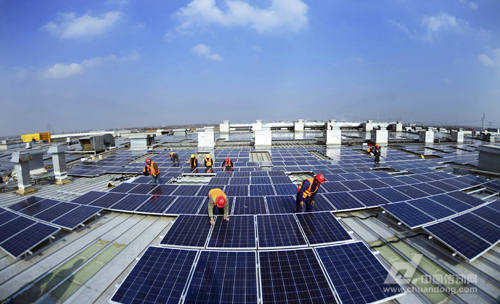Under the dual pressures of air pollution control and climate change negotiations, clean energy alternatives continue to increase. Among them, distributed photovoltaics that have been dormant for many years are ushering in their own “tuyereâ€. According to public information, unlike photovoltaic power stations on the ground, distributed photovoltaics are faced with a vast number of customer-end markets, with features such as small installed capacity, large quantities, and easy installation. With the release of a series of favorable policies, the industry has a brighter outlook and expectation for the future development of the photovoltaic industry: The potential market for photovoltaic power generation will reach more than one trillion yuan. Among them, in the face of the upcoming rush-installed '6.30' and the leader '9.30', the distributed photovoltaics will show an unprecedented explosion. Cakes in the domestic electricity market are constantly expanding. While limiting coal power, the demand for clean energy, especially photovoltaics, will increase accordingly. Public statistics show that China's photovoltaic industry has continued its upward trend since last year. The statistics of photovoltaic power generation released by the National Energy Administration show that as of the end of 2016, China's photovoltaic power generation had a new installed capacity of 34.54 million kilowatts and a cumulative installed capacity of 77.42 million kilowatts. And the cumulative installed capacity is the first in the world. Such a huge photovoltaic power station market has naturally led to the development of the industry. According to previous reports in the Nanfang Daily, the scale of the photovoltaic industry continued to expand. In 2016 alone, the output of photovoltaic cells was nearly 45 GW, a year-on-year increase of approximately 20%. The output of photovoltaic modules exceeded 50 GW, an increase of 20% over the same period of last year, and the newly-added PV grid installed capacity reached 34 GW, a year-on-year increase of 127%. The global scale of the production chain at each stage of the industry chain exceeds 50%, and continues to rank first in the world. The industry generally believes that the potential market for photovoltaic power generation in China will exceed RMB 1 trillion. At the same time, with the accelerated pace of “going outâ€, under the “One Belt and One Road†strategy, a number of companies are now operating in more than 20 countries around the world. Up to now, the built-up production capacity in overseas countries has exceeded 5 GW, and the globalization trend of production layout is obvious. Behind the layout of enterprises is the continuous growth of market capacity. Among them, distributed photovoltaic is becoming the focus of attention in the industry. Public data shows that in the first quarter of 2017, the newly installed capacity of photovoltaics was 7.43 million kilowatts, of which distributed new installed capacity far exceeded 2 million kilowatts, an increase of nearly 150% over the same period last year. Peng Yu, Policy Research Director of the Renewable Energy Special Committee of the China Recycling Economic Association once predicted that the on-grid PV benchmarking price in 2017 can only guarantee the benefits of poverty-relief projects. The bidding of ground-level power plants will become even more cruel. With this reduction, the advantages of distributed photovoltaics will become more apparent. After experiencing significant growth last year, distributed photovoltaics will usher in a truly explosive period, and the Chinese PV road that will enter the full development phase of centralized and distributed generation will become wider and wider. According to the Economic Daily report recently, distributed photovoltaics can be divided into industrial and commercial distributed and household distributed according to the size of installed capacity. Due to the construction standards and quality issues, China's industrial and commercial roofs that meet the requirements for installation of photovoltaic power plants account for only 20%, which makes Two years of looting of rooftop resources have become increasingly heated. At the same time, the roofs of households scattered throughout the suburbs and villages of China have become a rich mine to be mined. The Central Document No. 1 issued in 2017, “Several Opinions on Further Promoting the Structural Reform of the Agricultural Supply Side and Accelerating the Cultivation of New Agricultural and Rural Energy†also clearly stated that the implementation of the rural new energy action, the promotion of photovoltaic power generation, and the gradual expansion of rural power , gas and clean coal supply. It can be foreseen that under the current situation that large-scale ground-based photovoltaic power plants are facing limited power supply and limited installation space, in accordance with the current trend of decreasing prices of photovoltaic systems, distributed photovoltaics for self-use will gain higher profits, and will surely promote distributed photovoltaics to enter gold. Development period. It is true that as far as local consumption is concerned, PV distribution systems of various scales and in various forms are continuously exploiting the application space—“photovoltaic+applications†such as complementary fisheries, complementary forests, and photovoltaics for parking plants. Distributed application space. As new applications continue to emerge, the scope and mode of distributed applications will also expand. “This year is the real first year of the distributed photovoltaic market and the real first year of the mobile energy market. The development of this market will be much faster than most people think.†But the deputy researcher of the New Energy and Renewable Energy Division of the National Energy Administration Xing Yiteng believes that the next step is to promote technological progress, reduce costs, expand diversified applications, reduce costs and increase efficiency, and give full play to the role of state subsidies. Germany Power Strip,European Power Strip,Power Strip Converter For Europe,Outlet Power Strip CIXI KYFEN ELECTRONICS CO.,LTD, , https://www.kyfengroup.com
Photovoltaic industry ushered in warm spring distributed acceleration to expand application market
According to public information, unlike photovoltaic power stations on the ground, distributed photovoltaics are faced with a vast number of customer-end markets, with features such as small installed capacity, large quantities, and easy installation.